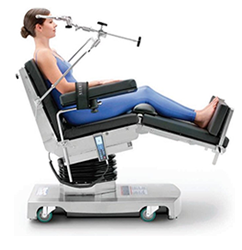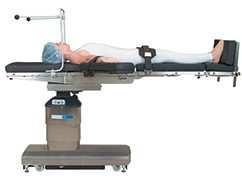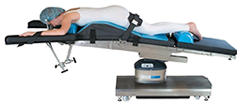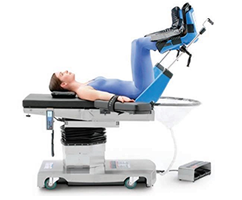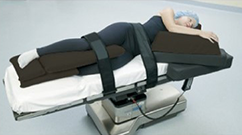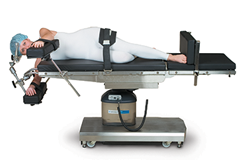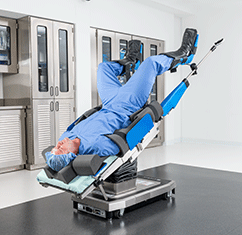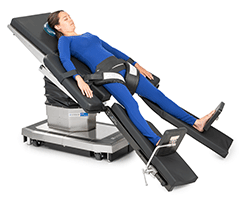The Complete Guide to Patient Positioning
THE IMPORTANCE OF PATIENT POSITIONING
Patient positioning is vital to a safe and effective surgical procedure. STERIS surgical table accessories and support systems provide complete flexibility and versatility for patient positioning with excellent radiolucency and higher patient weight capacities. Proper patient positioning in the operating room depends on the type and length of procedure, anesthesia access to the patient, devices required and other factors. Safely positioning the patient is a team effort. All members of the surgical team play a significant role in the process and share responsibility for establishing and maintaining the correct medical positions for patients.1,2
EXPLORE COMMON PATIENT POSITIONS
The goals of proper patient positioning include:
- Maintain the patient's airway and circulation throughout the procedure
- Prevent nerve damage
- Allow surgeon accessibility to the surgical site as well as for anesthetic administration
- Provide comfort and safety to the patient
- Prevent soft tissue or musculoskeletal and other patient injury
Explore our surgical tables
Patient Positioning Guidelines
Following standard patient positioning guidelines and practices helps to ensure patient safety and physical well-being before, during and after a procedure. A sufficient number of personnel should always be available during a patient procedure to position the patient safely and effectively. General positioning practices include having an adequate number of personnel, devices, and equipment available during a procedure to ensure patient and staff safety. The patient should be maintained in a neutral alignment, without extreme lateral rotation or hyperextension.
Ensure that pressure is not concentrated on one point in order to avoid pressure injuries. Pressure ulcers, localized injuries to skin or underlying tissue, can occur because of pressure or pressure in combination with shear and/or friction. A sedated or anesthetized patient is not always able to communicate physical feeling such as numbness, tingling, tissue temperature, and other issues.2
Patient Positioning Risk Factors
Various factors play a role in risk during a patient procedure as a result of positioning. Intrinsic and extrinsic factors can interact to contribute to the risk of developing pressure sores. Extrinsic factors may include pressure intensity and duration and overall effects of anesthesia. Intrinsic factors can include the overall health of the patient, and preexisting conditions such as respiratory or circulatory disorders, diabetes mellitus, anemia, malnutrition, advanced age, and body size.3 Additionally, the musculoskeletal system of the patient may be subjected to stress during patient positioning. When anesthetics and muscle relaxants depress pain, pressure receptors and muscle tone, the normal defense mechanisms cannot guard against joint damage or muscle stretch and strain. One of the main goals of proper patient positioning is to keep the patient's body as naturally aligned as possible while providing the surgical staff access to the surgical site, and quick, jerky movements should be avoided.3
Common Patient Positions
Of the common patient positions, there are variations of different patient positions which play a key role in minimizing the risk of positioning related issues, such as: respiratory problems, circulatory problems, nerve or muscle injuries, and soft tissue injuries.
High Fowler's Position
In High Fowler's position, the patient is usually seated (Fowler's position) at the head end of the operating table. The upper half of the patient's body is between 60 degrees and 90 degrees in relation to the lower half of their body. The legs of the patient may be straight or bent.
Jackknife Position
Jackknife position, also known as Kraske, is similar to Knee-Chest or Kneeling positions and is often used for colorectal surgeries. This type of position places extreme pressure on the knees. While positioning, surgical staff should place extra padding for the knee area.
Explore our Jackknife Position Accessories
Kidney Position
The kidney position resembles lateral position, except the patient's abdomen is placed over a lift in the operating table that bends the body to allow access to the retroperitoneal space. A kidney rest is placed under the patient at the location of the lift.
Explore our Kidney Position Surgical Table Accessories
PATIENT POSITIONING BY SURGICAL PROCEDURE
The different positioning of patients to be used also depends on the type of procedure, with the purpose to both provide optimal exposure and access to the surgical site and maintain patient comfort, among several other reasons.
Explore our Surgical Table Accessories
Positioning for Cardiovascular Procedures
The most common position used for cardiovascular procedures is the supine position. This type of position allows the best possible surgical access to the chest cavity. For coronary artery bypass grafting (CABG), the anterior thorax is exposed with the patient in a supine position. A roll is placed in the interscapular region to improve access to the sternum by extending the neck and elevating the sternal notch.
Positioning for Femoral-Popliteal Procedures
The supine position is used for Femoropopliteal (Fem/Pop) bypass surgery. Fem-pop is used to bypass narrowed or blocked arteries above or below the knee. The bypass restores blood flow to the leg. Typically, surgical table accessories such as the FEM POP Board will attach to the surgical table to increase lower body, intraoperative, fluoroscopic imaging coverage during the procedure.
Positioning for Cystoscopy/Urology/GYN Procedures
Variations of the lithotomy position are most commonly used in cystoscopy, urology or gynecology procedures. Surgical table accessories such as stirrups, split-leg positioners and well leg-holders are commonly used to support patient legs during procedures.
Positioning for Ophthalmic/ENT Procedures
The supine position with an additional headrest accessory, is most used for ophthalmic/ENT procedures. When the procedure is performed using a STERIS Surgical Table, a specialized adaptor accommodates standard Neuro and Eye-ENT-Neuro accessory attachments with cylindrical post attachments that are midline to the table.
Positioning for Bariatric/Split Leg Procedures
The lithotomy position in reverse Trendelenburg is most commonly used for bariatric/split leg procedures. Split Leg Positioners provide mid-line access to the patient with independent controls for full abduction/adduction as well as high and low lithotomy positioning.
Positioning for Kidney & Thoracic Procedures
A variation of lateral position with kidney elevation (flexion) is most commonly used for kidney and thoracic procedures. Lateral positioners, arm boards, headrests and restraint straps are used to safely position the patient for this procedure.
Positioning for Orthopedic Procedures
A variety of positions may be used for orthopedic procedures depending on the specific type of procedure. Common positions include supine with additional attachments for traction of lower extremities. Such procedures include hip arthroscopies and anterior hip replacements. Other common orthopedic procedures utilize Fowler's position (beach chair) for shoulder arthroscopy procedures.
Positioning for Shoulder Chair Procedures
Fowler's position is commonly used for shoulder arthroscopy procedures. Surgical tables may be articulated to place patients in a seated position or shoulder chair (beach chair) accessories may be used as an alternative. The patient is placed supine on the operating table and general endotracheal anesthesia is induced. The endotracheal tube should be taped to the contralateral side of the mouth to assure easy airway access during the procedure if needed. After induction, protective foam face masks and/or head restraints are used for ocular protection during the procedure. The patient is moved into the upright beach chair position in conjunction with the anesthesia staff to ensure that the patient does not become hypotensive during this positioning maneuver.
Explore our Surgical Table Accessories
References
1 Phillips, N. F. (2004). Berry & Kohn's operating room technique (10th ed.). St. Louis, MO: Mosby; St-Arnaud, D., & Paquin, M. (2008). Safe Positioning for Neurosurgical Patients. AORN Journal, 87 (6), 1156-1172. doi:10.1016/j.aorn.2008.03.004
2 Guideline for positioning the patient. (2017). AORN Journal, 105 (4), P8-P10. doi:10.1016/s0001-2092(17)30237-5
3 Rothrock, J. C. (2011). Alexander's care of the patient in surgery (14th ed.). St. Louis, MO: Mosby.
4 Patient positioning during anesthesia: Supine position. (2016, December 20). Retrieved from http://www.clinicalpainadvisor.com/anesthesiology/patient-positioning-during-anesthesia-supine-position/article/582929
 United States
United States
 Canada (EN)
Canada (EN) Canada (FR)
Canada (FR) Deutschland
Deutschland Italia
Italia United Kingdom
United Kingdom Australia
Australia New Zealand
New Zealand Singapore
Singapore Brasil
Brasil México
México
